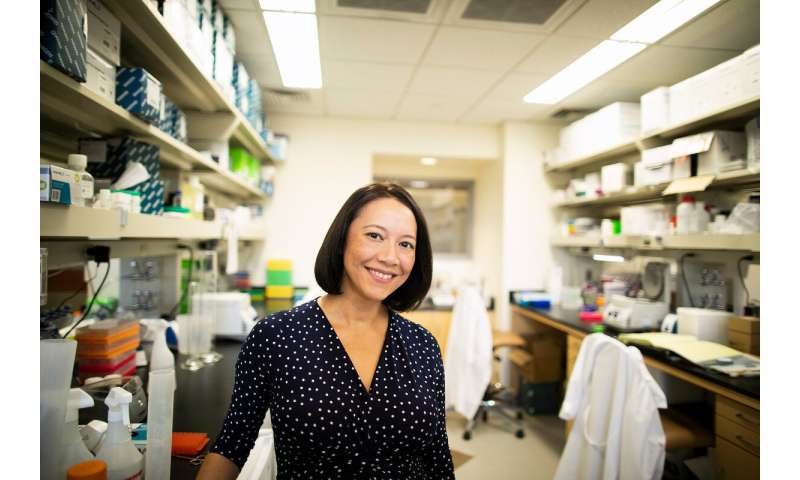
How we prepare food matters to us, surprisingly deeply, it turns out.
Scientists have recently discovered that different diets—say, high-fat versus low-fat, or plant-based versus animal-based—can rapidly and reproducibly alter the composition and activity of the gut microbiome, where differences in the composition and activity can affect everything from metabolism to immunity to behavior.
“What we didn’t know was whether the form of the food also mattered,” said Rachel Carmody, assistant professor in the Department of Human Evolutionary Biology. And the answer is apparently yes.
Carmody co-led teams at Harvard and the University of California, San Francisco, in an examination of how eating cooked versus raw food affected gut microbial residents, increasing our understanding of how these microorganisms have evolved with us. The research was published Monday in Nature Microbiology.
Carmody has been intrigued by that question since grad school. “Food processing affects the way our bodies digest food,” she points out. “Physical techniques like grinding or pounding can disrupt cells and make their nutrients more accessible. Cooking takes this a step further because in addition to physically transforming food, it chemically transforms it as well.” By processing something that is hard to digest, she said, “You essentially externalize part of the digestive process, and therefore the remaining bits of digestion become more efficient.”
Carmody served as first author and co-senior author on the paper along with Peter Turnbaugh, an associate professor of microbiology and immunology and a member of the executive leadership of the UCSF Benioff Center for Microbiome Medicine.The two researchers hypothesized that because cooking increases nutrient absorption in the small intestine, the lesser fraction of nutrients reaching the colon would affect competition among the 100 trillion or so microbes that reside there, leading to downstream effects for the host.
To explore the possibilities, Carmody and Turnbaugh first focused on two types of foods that are believed to have provided the bulk of calories during most of human history: meat and starch-rich root vegetables. To test how preparation influences intestinal microbes, they fed mice raw and cooked variants of these foods and measured the resulting changes in gut microbial community composition and function. While the meat eaters’ microbes did not vary much, no matter the preparation, the sweet potato eaters’ did—by quite a lot and within hours. A subsequent experiment in which human participants ate plant-based diets served raw versus cooked confirmed that these effects also held true in human guts.
To work out the mechanisms driving these gut microbial shifts, the team conducted a range of additional experiments. Follow-up studies in which mice were fed identical chow diets that varied only in the digestibility of the starch component reproduced many of the microbiome changes seen on the raw-versus-cooked-sweet-potato diet, confirming starch digestibility as a key mechanism. Further evidence came from feeding trials using a range of vegetables, which found that the effects of cooking on the gut microbiome were most profound for starchy foods compared with nonstarchy foods like beet and carrot. Researchers also noticed that mice fed raw diets lost weight.

Intriguingly, the team also uncovered evidence for a secondary mechanism: heat-induced inactivation of native foodborne antimicrobial compounds.
“A growing plant produces a range of antimicrobial compounds to defend itself. When these plant foods are cooked, these compounds are largely inactivated,” Carmody said. “But when these plant foods are eaten raw, some of these antimicrobial compounds act against microbes in the gut—and some microbes are more susceptible than others.”
Finally, the researchers transplanted gut microbes from mice fed raw versus cooked plant foods into a group of germ-free mice that were fed a diet of standard chow. The findings were striking and somewhat surprising: the recipients of gut microbes conditioned on raw food gained more weight and body fat than recipients of gut microbes conditioned on cooked food. The raw-food-exposed microbial community had selected for microbes that made the host hungrier and returned more of the energy that the host failed to digest on its own. So although eating raw plants provided less energy overall, associated changes to the microbial community appeared to help make up some of the slack.
“Our gut microorganisms not only react to make best use of whatever is available, they’re extraordinarily adaptable,” said Carmody. Rather than evolving over millennia as humans do, the gut microbiome can change in a matter of hours to take advantage of the environment. “That adaptability might be one of the keys to us surviving or developing as a species,” she said.”Until quite recently the human food supply was highly volatile. You had seasonality to worry about. If you went out hunting, you never knew if you would be successful or come back empty-handed. Plasticity in the gut microbiome could have served as an important energetic buffer.”
This discovery launches an array of new questions, said Carmody. One area of inquiry will be exploring how gut microbes handle the antimicrobial properties of some raw vegetables, and how these foodborne antimicrobial compounds affect our health more broadly. Another will look at whether cooking has represented a selective pressure favoring co-evolution between humans and our resident microbes.
“It’s pretty clear that the human body has been shaped by our long history of cooking, but this study suggests the human gut microbiome would have been affected, too,” Carmody said.
Other authors of the paper included Kylynda Bauer, Katia Chadaideh, and Vayu Maini Rekdal of Harvard University; Corinne F. Maurice of Harvard and McGill universities; and Jordan Bisanz, Elizabeth Bess, Peter Spanogiannopoulos, and Qi Yan Ang of UCSF.
“It was exciting to see that the impact of cooking we see in rodents is also relevant to humans,” said Turnbaugh in a statement from UCSF. “We’re very interested in doing larger and longer intervention and observational studies in humans to understand the impact of longer-term dietary changes.”
Source: Read Full Article
